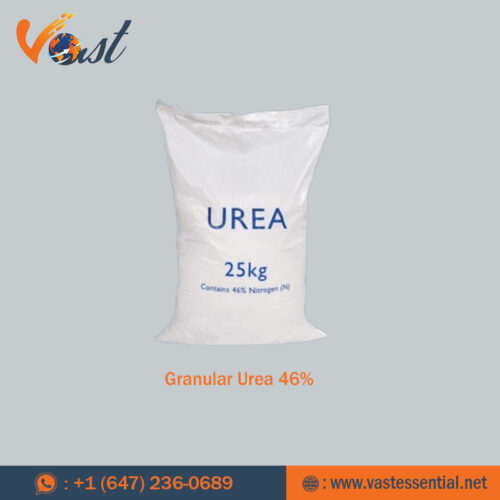


Granular urea fertilizer 46%
Chemical fertilizers are divided into different types based on ingredients (mainly nitrogen, phosphorus and potassium) and the purpose of adding them to the soil can be compensated for the lack of element needed for plant growth. Choosing the right chemical fertilizer requires knowing the characteristics and properties of the soil, this recognition is usually done by sampling the soil and determining important parameters such as pH, nitrogen, phosphorus and.
Granular urea fertilizer is a type of chemical fertilizer and a subset of chemicals.
Nitrogen is the main ingredient of nitrogen fertilizers and one of the main elements of plant growth and development. Urea fertilizer contains 46% nitrogen and is known as a rich source of this element, its appearance is white crystal and is composed of ammonia and carbon dioxide.
All plants need nitrogen, a substance that helps plant leaf formation and protein formation, and affects chlorophyll production. Nitrogen is present in the air but plants are unable to absorb nitrogen from the atmosphere. Urea quickly affects plants. These fertilizers have a high solubility. Therefore, in addition to soil, they can be absorbed through the foliage of the plant, but to increase the amount of nitrogen uptake, the method of injection into the soil is more recommended.
Urea chemical fertilizer:
Urea chemical fertilizer, as its name implies, is obtained from a special chemical formula in the laboratory. This very useful fertilizer, which is produced in the form of snow-white crystal balls, is in fact an organic compound.
Production of granular urea fertilizer:
The process of producing granular urea fertilizer is such that ammonia and carbon dioxide gas are transferred to the urea synthesis unit after compression and in this unit ammonia and carbon dioxide are converted to urea under certain temperature and pressure conditions and after evaporation and purification. The urea is transferred to the granulation unit and the final product of urea fertilizer in this unit is solid granulated and granulated. Granular urea fertilizer is white and in sizes of 2 to 4 mm, which has a larger grain size than Peril urea fertilizer. Both granule and peril urea fertilizers are approximately similar in chemical properties and contain 46% nitrogen. It should be noted that the grain strength in the granule model is higher than the peril model.
The process of producing granular urea fertilizer is such that ammonia and carbon dioxide gas are transferred to the urea synthesis unit after compression and in this unit ammonia and carbon dioxide are converted to urea under certain temperature and pressure conditions. After, evaporation and purification the urea is transferred to the granulation unit and the final product of urea fertilizer in this unit is solid granulated and granulated. Granular urea fertilizer is white and in sizes of 2 to 4 mm, which has a larger grain size than Peril urea fertilizer. Both granule and peril urea fertilizers are approximately similar in chemical properties and contain 46% nitrogen. It should be noted that the grain strength in the granule model is higher than the peril model.
Due to the similar effect of granular and peril urea fertilizer in the agricultural sector, it seems that each of these two models is more popular in different regions due to the presence of more of that sample in that market and has a somewhat psychological aspect.
Granular urea fertilizer 46%
Nitrogen fertilizers, of which 46% urea fertilizer is one of the types, has played a very important role in increasing world food production in the last half century, and according to some statistics, it accounts for about 60% of global chemical fertilizer consumption. Nitrogen is one of the most important nutrients needed by crops and orchards and according to some theories after water is the most important factor limiting plant growth. Urea, which has the highest amount of nitrogen (46%) among solid nitrogen fertilizers, is produced and marketed in two samples of granules and perils.
Granular urea fertilizer analysis:
What is urea fertilizer or nitrogen fertilizer made from?
Urea fertilizer, the main composition of which is urea, must first be prepared in the form of urea granules.
Urea granules are a viscous substance that has better resistance to air humidity and is also larger in size. Therefore, researchers have found that extracting urea chemical fertilizer from urea granules will have better results. In fact, the particle size in urea granular type is narrower than its peril type, which makes it easier to disperse and disperse. In fact, the process of production and ultimately absorption by the plant in this form and type is easier and more practical.
Uses of urea:
growing plants and vegetables:
- A variety of flowers and ornamental plants
- apartment flowers
- Garden
- Gardens
- vegetables
- farms
- Grasslands and so on
Advantages of using urea fertilizer:
1- Production of high amounts of nitrogen for the plant and high yield compared to other artichoke fertilizers along with cost-effective.
- Storage due to lack of fire and explosion
3- Possibility of using as a spray and injection into the soil
4- Possibility of combination with other fertilizers (with ammonia phosphate, diammonium phosphate, superphosphates)
5- For cases where the soil is acidic, the use of this fertilizer is recommended.
How to use urea fertilizer
When urea is deposited on the soil surface, it is converted to ammonium bicarbonate by a chemical process. Ammonium turns into a gas, if it is not protected, it will be destroyed.
This means that for maximum efficiency of this fertilizer, it must be mixed with soil. Of course, this problem does not arise in the method of spraying on leaves. There are two ways to achieve this goal: either urea must be spread on the soil surface and then immediately plowed well, or urea must be injected directly into the soil.
In the second method, urea can be spread on the soil surface and then with a heavy irrigation, the dissolved urea can be directed to the lower parts of the soil.
Granular urea fertilizer manufacturers
The raw material of Iranian granular urea fertilizer is produced in Pardis, Shiraz and Kermanshah petrochemicals. To buy from these manufacturers from outside Iran, it is better to leave the work to commercial service companies that are in compliance with all laws and take responsibility for your purchase to reduce the risk of importing raw materials from Iran.
Granular urea fertilizer price
In order to receive the table of types and price list of granular urea fertilizer and buy it, you can contact the experts of the petrochemical raw materials sales department of Vast Company or see the latest price of these materials from the chart on the product page.
In this article, we tried to introduce granular urea fertilizer and its properties. And we named its producer. You can refer to the website of Petrobon Trading Company to know the purchase price of raw materials and see the weekly price change of each product in a graph. We hope you find this article interesting and useful.
